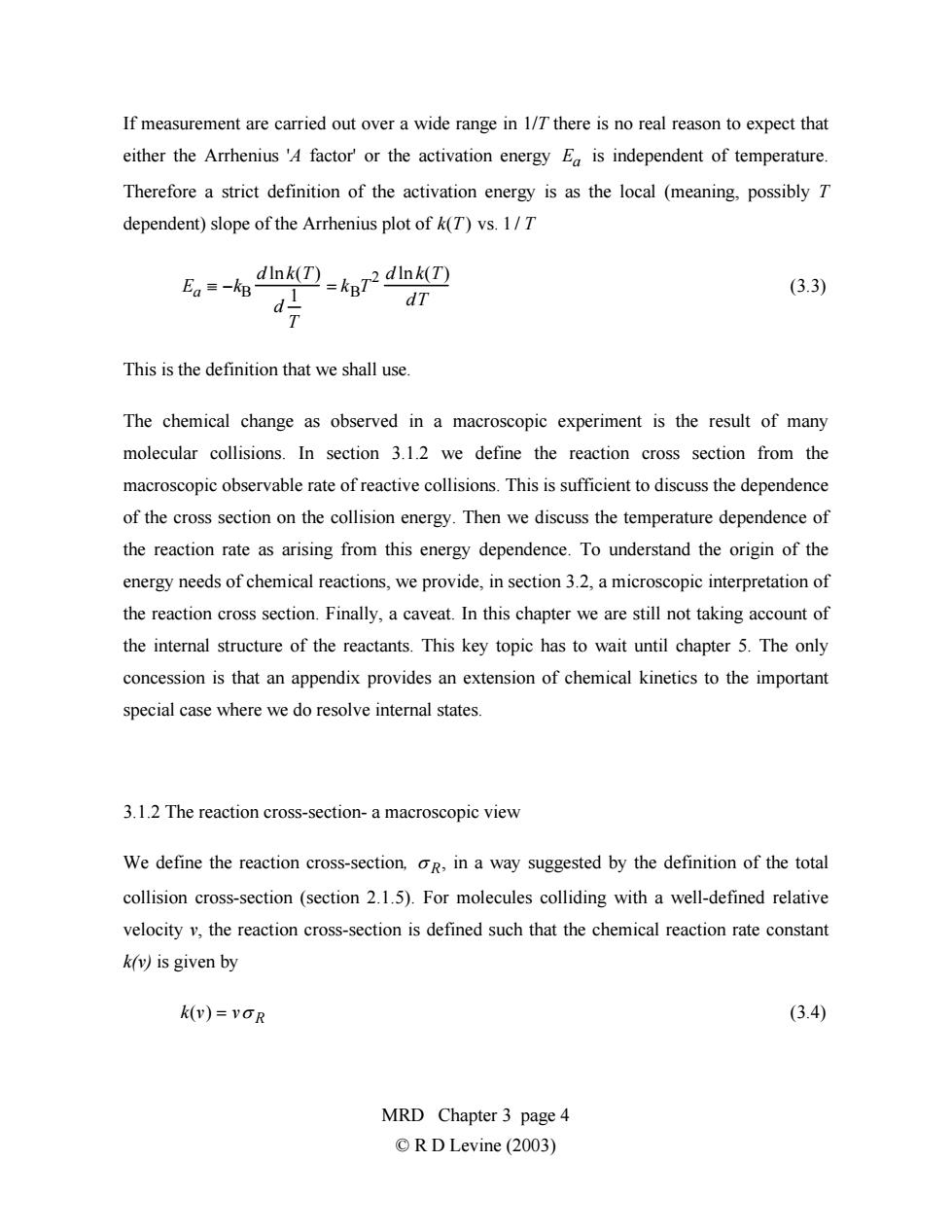正在加载图片...

If measurement are carried out over a wide range in 1/T there is no real reason to expect that either the Arrhenius 'A factor'or the activation energy E is independent of temperature. Therefore a strict definition of the activation energy is as the local(meaning,possibly T dependent)slope of the Arrhenius plot of k(T)vs.1/T Ea=-kB- 0-知2D (3.3) d dT This is the definition that we shall use. The chemical change as observed in a macroscopic experiment is the result of many molecular collisions.In section 3.1.2 we define the reaction cross section from the macroscopic observable rate of reactive collisions.This is sufficient to discuss the dependence of the cross section on the collision energy.Then we discuss the temperature dependence of the reaction rate as arising from this energy dependence.To understand the origin of the energy needs of chemical reactions,we provide,in section 3.2,a microscopic interpretation of the reaction cross section.Finally,a caveat.In this chapter we are still not taking account of the internal structure of the reactants.This key topic has to wait until chapter 5.The only concession is that an appendix provides an extension of chemical kinetics to the important special case where we do resolve internal states 3.1.2 The reaction cross-section-a macroscopic view We define the reaction cross-section,R,in a way suggested by the definition of the total collision cross-section (section 2.1.5).For molecules colliding with a well-defined relative velocity v,the reaction cross-section is defined such that the chemical reaction rate constant k(v)is given by k(v)=VOR (3.4) MRD Chapter 3 page 4 ©R D Levine(2003)If measurement are carried out over a wide range in 1/T there is no real reason to expect that either the Arrhenius 'A factor' or the activation energy Ea is independent of temperature. Therefore a strict definition of the activation energy is as the local (meaning, possibly T dependent) slope of the Arrhenius plot of k(T) vs. 1 / T Ea ≡ −kB d ln k(T) d 1 T = kBT2 d ln k(T) dT (3.3) This is the definition that we shall use. The chemical change as observed in a macroscopic experiment is the result of many molecular collisions. In section 3.1.2 we define the reaction cross section from the macroscopic observable rate of reactive collisions. This is sufficient to discuss the dependence of the cross section on the collision energy. Then we discuss the temperature dependence of the reaction rate as arising from this energy dependence. To understand the origin of the energy needs of chemical reactions, we provide, in section 3.2, a microscopic interpretation of the reaction cross section. Finally, a caveat. In this chapter we are still not taking account of the internal structure of the reactants. This key topic has to wait until chapter 5. The only concession is that an appendix provides an extension of chemical kinetics to the important special case where we do resolve internal states. 3.1.2 The reaction cross-section- a macroscopic view We define the reaction cross-section, σ R, in a way suggested by the definition of the total collision cross-section (section 2.1.5). For molecules colliding with a well-defined relative velocity v, the reaction cross-section is defined such that the chemical reaction rate constant k(v) is given by k(v) = vσ R (3.4) MRD Chapter 3 page 4 © R D Levine (2003)